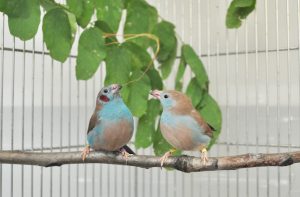Dancing Animals: Dance Like an Animal
Dancing Animals
In a search for “dance” in the news I discovered an article that was published on November 19th by National Geographic announcing that there is bird that tap dances to attract mates. For the first time, researchers captured the rapid step dancing performed by both female and male blue-capped cordon-blue birds on film. Scientists were already aware that the blue and tan African finches bob their heads and sing as a part of their courting display, but were unaware of their impeccably fast footwork. Their tap dancing is so fast that it’s too fast for humans to see in real time. This video revealing the birds dancing technique is definitely worth a watch:
The Fred Astaires of the bird world are unique in that there is no other species discovered to have the same type of tap dancing behavior. Unlike other species that partake in courting displays, the blue-capped cordon blues are monogamous. This reveals that these birds dancing skills may really affect them as both males and females are picky about their mates. In addition to dancing, the male and female blue-capped cordon bleus court their mate by holding a piece of nesting material in their beak while singing and bobbing up and down.
 The birds dance about three steps in less time than it take humans to blink. Scientists are referreing to their movement as tap dancing because they believe that the purpose of the dancing goes beyond the fancy footwork. They believe that the sound produced by the stepping provides information about the bird dancer’s fitness ability. Birds that produce more sound with their tap dancing over several minutes are signaling to their potential mate that they are in good health. Researchers are beginning to focus more on the visual attributes of bird’s courtship than their song. Who knows? Maybe we’ll learn of even more dancing birds as a result!
The birds dance about three steps in less time than it take humans to blink. Scientists are referreing to their movement as tap dancing because they believe that the purpose of the dancing goes beyond the fancy footwork. They believe that the sound produced by the stepping provides information about the bird dancer’s fitness ability. Birds that produce more sound with their tap dancing over several minutes are signaling to their potential mate that they are in good health. Researchers are beginning to focus more on the visual attributes of bird’s courtship than their song. Who knows? Maybe we’ll learn of even more dancing birds as a result!
There are also other types of dancing that birds do that have already been discovered. Cockatoos have blown up the Internet world with their dance skills. A neurobiologist of the Neurosciences Institute of San Diego used a famous dancing bird name Snowball to prove that cockatoos have natural rhythm and can adjust to the tempo of a song. The manakin bird, native to Colombia and Ecuador, has a mating dance that is possibility the most unique in the animal kingdom. After making a ticking noise at a prospective mate, they flap their wings at a pace so rapid the naked human eye can’t catch it. Then, after a short flight, the birds land on a branch and perform a “moonwalk”. Check it out!
https://www.youtube.com/watch?time_continue=21&v=K1Ul0fwGm8Q
Birds are not the only animals that have been discovered to have dancing abilities. Honeybees use a “waggle dance” to communicate as a way to find food. The peacock spider does a dance as part of its mating ritual, opening it’s colorful abdomen like a flap as part of its dance. Dung beetles perform a 360 degree turning dance on top of their dung balls to protect them from rivals tying to steal them. It’s even argued that freshwater algae do a “dance” to reproduce. Their “waltz” and “minuet” is described as colonies of algae connecting to each other with their flagella and using their free flagella to spin around on an axis. The colonies then orbit back and forth as if they were held together by an elastic band (the minuet) or orbit around each other, much like waltz dancers turn around each other. The dances help the algae clump together to facilitate reproduction.
It’s not surprising that animals dance, and I assume that they dance for some of the same reasons that humans do including courtship and enjoyment. We may be more connected to dancing animals than we acknowledge. In the 1900s, several dances were named after animals including the turkey trot, the bunny hug, and the kangaroo hop. In Egyptian folklore dance, the Saidi dance imitating the horses who are trained to dance like humans. In more recent times we’ve danced the funky chicken among other animal friendly dances. I suspect that there will be more humans dancing animals and animals dancing like humans in the future. Only time will tell.
“Dancing Animals” Article by Ziva.

